Sumo: fighters, law, engineering, history, interesting facts
Sumo wrestlers at first glance seem a bit strange and awkward. This applies to the athletes, dressed almost in a loincloth, having no means small dimensions. The whole fight takes place in a small circle, and precedes the ceremony lasts longer than the match itself. If you look into the history of this martial art, it should be noted that this sport has a unique technology and characteristics. Most of the participants of the Japanese struggle to adhere to a special diet should and unique training methods.
The origins of
Viewed sports in the Land of the Rising Sun for a long time relates to the national forms. The origin of the competition Sumo dates back to 300 BC. All ceremonies and rules are followed strictly, ranked as a sacred tradition, and the building and playground for performances equivalent to the Shinto temple.
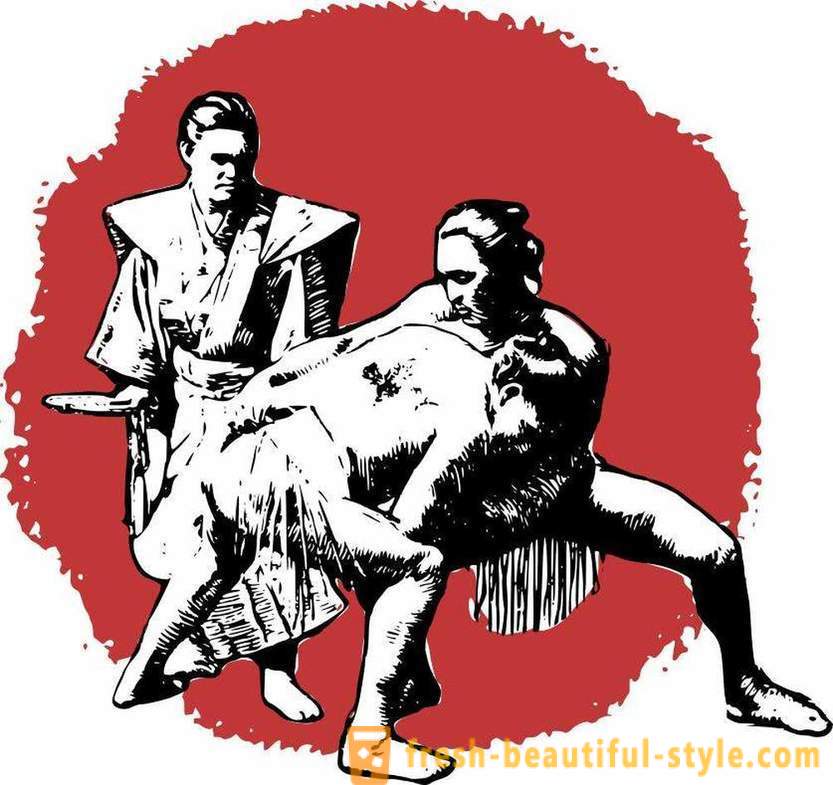
is not known the date of occurrence of practicing athletes in the sport. It is believed that the first sumo wrestlers called Tagima-but-Kehaem and Nomi-no-Sukune. They had to compete against each other at the request of Emperor Suining. Display sumo were seen in the most ancient Japanese tombs. Attributed to the emergence of all the rituals ancient spirits "kami".
The special importance of the competition got in the seventh century AD, when they became members of the samurai. These fights were called "kandzin-dzumo", different minimum requirements for the rules, often ended in the death of one of the athletes. Second Embodiment organizations fighting more humane (they were held in the temples, and served to collect certain funds for the development and maintenance of these objects).
Features
At the end of the 12th century struggle almost stopped in its development. This is due to the decline of the power of the imperial court and the emergence of the samurai category, destabilizing the political situation in the country. During this period, the last fight held in 1174. About informal battles in the sport indicates many manuscripts and pictures, which show the athletes the characteristic configuration and in the appropriate attire. It is believed that the appearance of the site for sumo as a circle, separating participants from the audience, timed to coincide with the tournament, organized warlord Nobunaga O. in the 16th century. At that time, the fighters put on hip belt, which differ in the rigidity of the modern "mawashi". The rest of the equipment used today, appeared in the same era.
Modern sumo rules and equipment
In this regard, the countdown began to the Shinto shrine in Tokyo, Tomioka. Fights were organized periodically with 1684. For example, former samurai, known as Ikadzuti Gondal, has developed specific rules of combat, as well as build the arena, the configuration of which is relevant to this day. In "rikishi" popularly called sumo wrestlers. Soon they acquired the status of professional athletes and national sport and is now considered to be sacred.
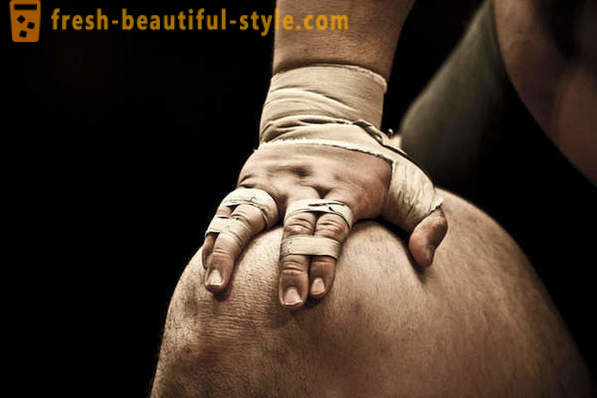
The rituals and pose
Before the main process of attack and defense in the confrontation athletes performed a series of special postures and rituals. This tradition has existed since ancient times, is associated with Shintoism. One of the main such "greetings" is to raise one leg and performing a few sharp blows it on the site, looking at the face of his opponent. The goal - to scare the enemy, the name of the pose - "Sicko." As noted in the legends, the same ritual takes place the goddess Amaterasu, trying to reason with a naughty brother Susano (Shinto mythology).
Below are a few more interesting traditions associated with this sport:
- Sumo wrestlers before the match start clapping. It is a kind of symbol of beginning and end of prayer.
- The meaning of the following ritual is spreading salt fighters. It symbolizes an act of purification from evil spirits.
- match referee wears a bathrobe, clearly distinguishes it from all the other participants and spectators. Clothing is strikingly similar to modern counterparts Shinto priests and persons listed as in the Middle Ages to the imperial court of Japan.
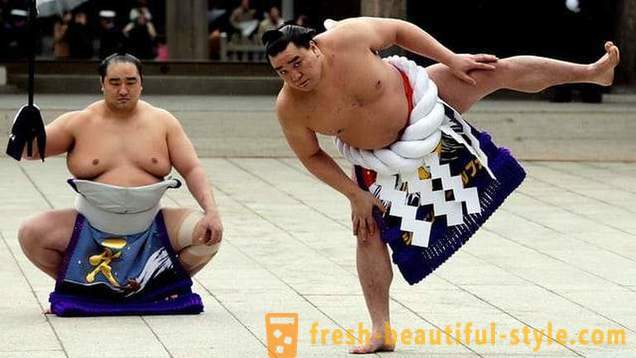
Golf
Two rival, standing on a square platform made of clay and sand, look at each other. The platform is raised slightly above ground level. Its dimensions:
- The total width - 5700 mm.
- height - from 340 to 600 cm
- The diameter of the central circle ( "Doha") - 4570 mm.
- material to indicate the boundaries of the element - rice straw wicker.
- Additional equipment - canopy with colored tassels hanging down, raised high above the platform.
.
After each confrontation pad dismantled. The winner in this fight against the Japanese determined if he was able to push the opponent out of the circle or straw made him fall to the ground. When you touch any part of the athlete (except the feet) a clay base, he is a loser round.
Athletes often have long hair tied in a complicated knot, like other medieval samurai hairstyles. They wear big belt ( "mawashi"), which is used to capture opponents, throws and cuttings. Often fight lasts only a few seconds. The main difficulty is the large mass of athletes. Sumo weight can vary from 150 to 200 kilograms, and even more.
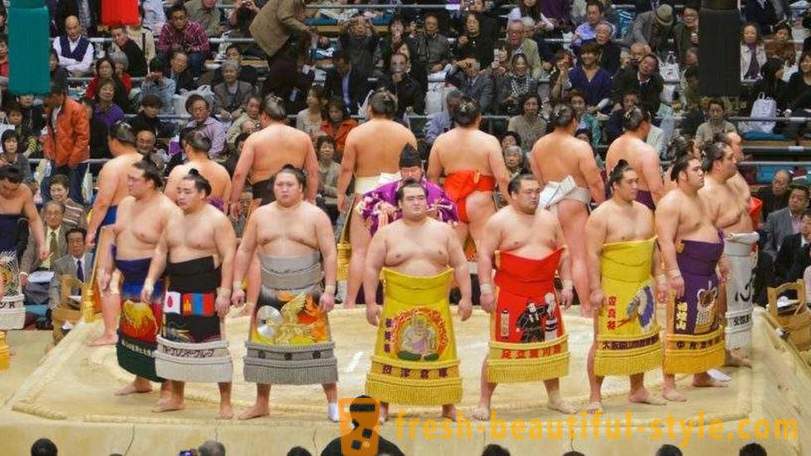
Rank
Many sumoists in Japan and abroad are the real stars. This is especially true winners of different championships and tournaments at Sumo Federation. They get the status of "yokozuna" - the main leader.
It is noteworthy that such success is achieved not only the indigenous people of Japan, but the natives of Hawaii and Mongolia. Popular fighters are often invited into private homes for the ritual cleansing of the "evil spirits" (ceremony - "setsubun"). Sumo wrestler throws indoors beans while shouting a special phrase denoting the expulsion of demons and come to the house of luck. Japanese athletes of this sport referred to as "rikishi". The designation includes two characters symbolizing the "warrior" and "strength." Only six leagues, federations, there are over 650 rikishi.
Maku-uchi
This Sumo tournament includes over 40 of the best representatives of the sport. In this regard, a high level of popularity it is completely justified, including the media interest. The leader is a "yokozuna", which gets its status after winning two major rating actions ( "hon-base") in a row.
Annually six such tournaments in Osaka, Fukuoka, Nagoya and Tokyo. Each of them lasts 15 days. By 2018, the history of this sport officially has only 72 yokozuna, indicating the incredible complexity of obtaining said title.
The traditions of the pre-fight
The fighters appear on the "Doha" on the western and eastern part of the ring. The right side of the first output is given, the following from where the sun rises. Next rikishi are in the center of the circle, placed strictly for special lines ( "sikiri-Sen"). Among themselves they in such a position shared by only a few centimeters.
Then begins the traditional looking into each other's eyes, and the ritual of "Sicko" (stamping foot and claps his hands). These seemingly useless exercises not only are familiar and historically related to customs, but also warm up the muscles of athletes.
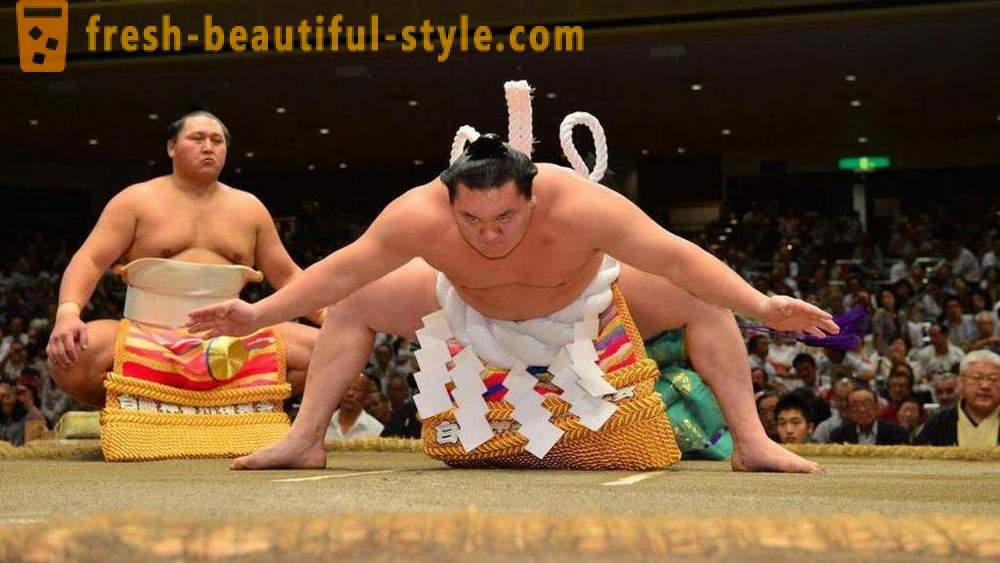
Daily customs
At each stage of the official competition matches conduct low-level sumo until it comes time matches "Maku-uchi" and "Juri". Before round fighters have carried out ritual "Sicko", cited above, clothed in special clothes. In addition, the judges check the belt (mawashi) to verify the absence of any weapons and prohibited items of equipment. For yokozuna there is a special ritual. It represents a yield in a circle with the performance of more complex and lengthy variations Sico. The rite is allowed to participate to the other two rikishi present at Doha.
The basic rules of sumo
The main rules of the struggle we simple. Touching any part of the body other than the feet, the ground outside the circle leads to defeat.
During the fight is forbidden:
- Grabbing opponent's hair.
- Squeeze eyes.
- punch (slapping hands allowed).
- Strangle enemy.
- Capture mawashi fighter in the groin area.
sumo, used a forbidden technique will automatically be deemed a loser. The same shall apply to an athlete who has untied the process equipment. Also defeated counted fighter who can not continue the match due to an injury or as desired. The referee at the end of the match signals the reception, which has led to a win.
In this sport does not provide separation of athletes in weight categories. For example, the rikishi small height and weight may gain an advantage at the expense of dives and better maneuverability on the court.

Women and foreigners in the fight
Girls in sumo may only participate at the amateur level. In professional tournaments are forbidden duels between the fairer sex. To one of the most advanced centers in the part of the female sumo refers Brazil.
Despite the fact that, historically, were leading the Japanese representatives of other countries in this sport could prove to be very good. The wrestler, who won the last time the maximum number of victories in major competitions - Hakuho Xie, a native of Mongolia (real name - Davaadzhargal Munhbatyn). According to statistics, currently among the professional sumo more than five per cent of the foreigners.
Interesting information
Here are some interesting facts regarding the fight said:
- The longest match sumo lasted 32 minutes, including two stages, "mizu-iri" (short breaks, declared when entering the game to a standstill).
- The leader in number of wins in a row is Sadadzi Futabayama (1912-1968 year).
- The heaviest representative of this type of struggle - the Satoshi stole. He himself from the border with Mongolia, Buryat settlements. Its weight - 271 kg.
- athlete remuneration depends on his rank. In the month of yokozuna receives about three million yen, and Juri - about 900 thousand.
- After a serious car accident involving a Japanese sumo wrestler Sitodzumi federation banned the practice of professionals in the sport driving.
- Referee ( "gedza"), as well as fighters, attached to his profession with 16 years. Typically, they work in this area until the retirement age. Their equipment and the equipment depends on the grade and the professional growth of judges awarded the honorary insignia.
- Each referee in the sport has a special short dagger (sword "tanto"). It is intended for ritual suicide in the case of serious errors or decision obviously the wrong decision.
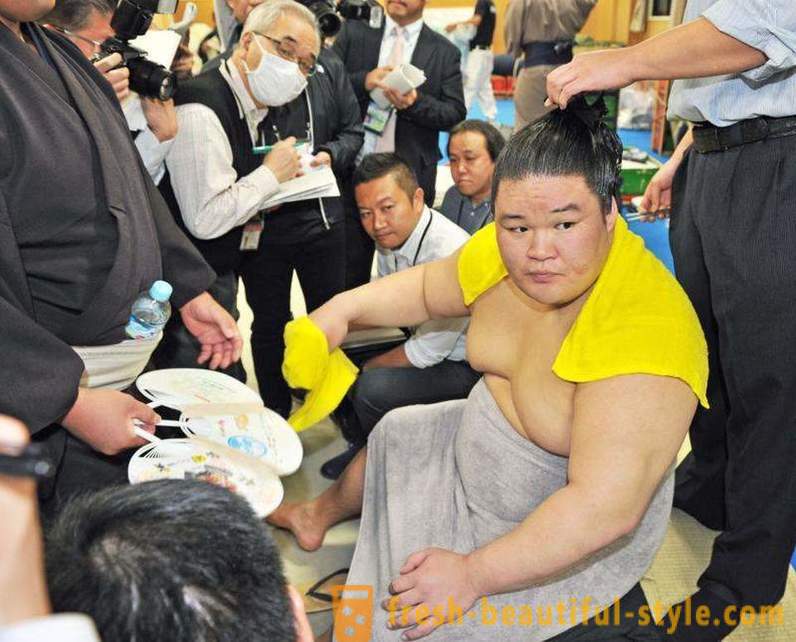
on the regime and diet sumo
Strictly regulated rules prohibit fighters at the initial stage of career to choose their own clothes. Also, athletes should grow their hair, to tie them to specific units ( "ten-magician") in the image of the samurai hairstyles in the Middle Ages. I wear it all the time they need. Wardrobe items for beginners are allowed only from inexpensive cotton shoes - sandals made of wood (including the cold season). Increasing the rank of sumo ladder gives the opportunity to buy and choose the more expensive clothes. To display themselves in a professional wrestlers are required to be trained in special schools. This is allowed only if there is a person of secondary education. Fans who showed good results, have the right to start fighting at once with the third level ( "makushita").
Athletes maximum ascetic lifestyle. They do not have a home, family and many other pleasures inherent in ordinary people. Each day begins with a grueling and monotonous workouts. The main social circle - mentors and the same fighters. Particular attention is paid not only to morals sumo wrestler, but his physical condition.
We should also mention about the diet of athletes. The main diet of the Japanese way is called "tyanko-nabe". This includes a special protein rich stew. The main components of ingredients of food: vegetables in chicken broth, meat, fish. The composition is designed so that the fighter can quickly gain weight. By the way, this "delicacy" is served in some restaurants people unrelated to sumo.













































